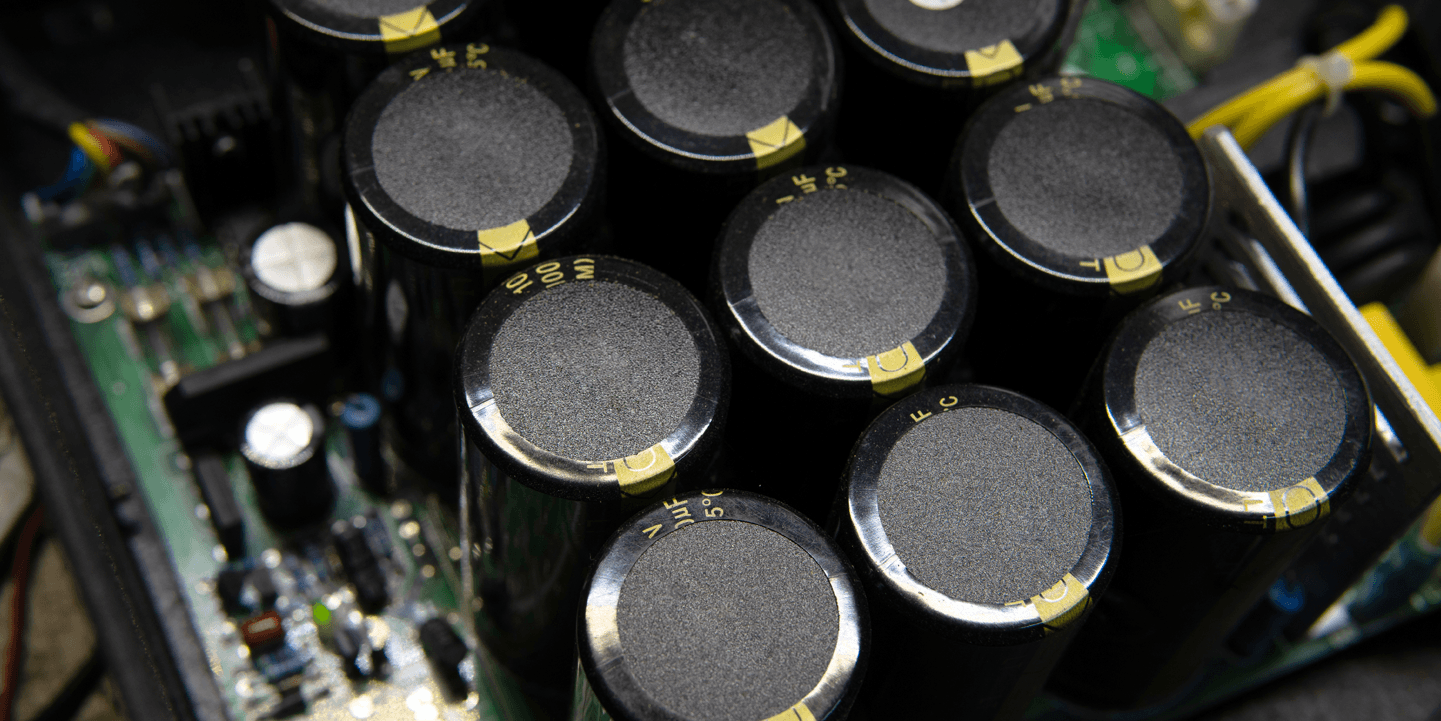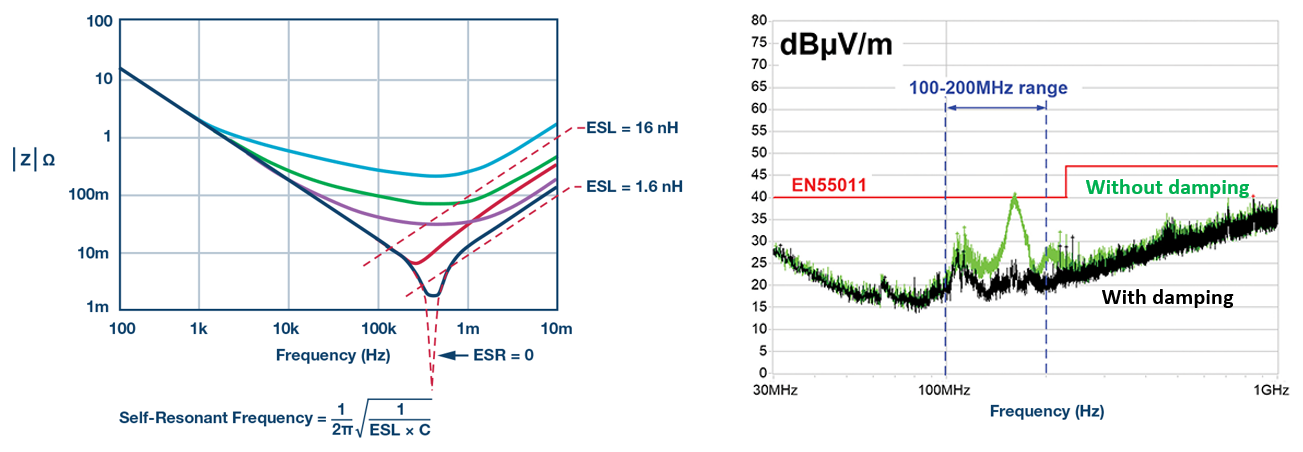How To Choose Capacitor Value To Filter Power Supply Noise

Whatever regulated ability supply needs to exist designed to have low noise at the input and output to the regulator section. Getting racket low relies on selecting the right filter capacitor for your supply. Depending on the electric current, these capacitors can be quite large, or you may demand to place a big number of capacitors in parallel. With the correct capacitor (or capacitor bank), yous'll be able to dampen voltage ripple from your rectifier while ensuring a long lifetime.
Although most subjects involving "filter capacitors" only refer to the output capacitor on a rectifier, it can also refer to the capacitor on the output of a voltage regulator. A filter capacitor could likewise refer to components used in an EMI filter on the input to a power supply. Fortunately, some of the aforementioned principles apply when selecting the all-time capacitors for power supply filtering. Take a look at our guide to see how to select the power supply capacitor yous need.
What are the Best Capacitors for Power Supply Filtering?
Every bit much as nosotros would like to just go onto DigiKey and bring upwards a page for filtering capacitors, this route doesn't exist. The truth is, unlike capacitors are useful for dissimilar purposes, and the specifications in various capacitors determine its advisable application. Obviously, you'll need to size the capacitor to the appropriate value to provide ripple suppression (larger is better), but information technology goes beyond simply computing capacitance.
To start selecting the best capacitors for ability supply filtering, you need to go into a capacitor datasheet and delve through some specifications. Some of the important specifications are as follows:
-
Capacitor fabric: Your capacitor might be a ceramic, electrolytic, tantalum, polyester, or other material. This determines the useful capacitance range, as will equally other specifications like the voltage rating and parasitics.
-
Working voltage rating: This basically tells you lot the maximum DC or AC RMS voltage that can be applied to the capacitor. The specified working voltage is valid inside a certain operating temperature range, which may be displayed on a graph.
-
Parasitics or self-resonant frequency: These specifications are stated in different ways, depending on the manufacturer. The manufacturer might only country the ESR and ESL values, or the ESL and Q-factor values, which can exist used to summate the cocky-resonant frequency and bandwidth. Alternatively, the impedance spectrum volition be shown in a graph, which can so be used to calculate the ESR and ESL values.
-
Temperature coefficient: Most designers don't worry about this, but it becomes important every bit the capacitance of a real capacitor will alter with temperature. Therefore, you should cull a capacitor with the smallest temperature coefficient if your production will operate over a wide temperature range.
-
Polarization: Filter capacitors for DC circuits have some specified polarization, which states the management the electric field should point across the capacitor. Excessively big AC voltage across a polarized capacitor can destroy the component prematurely.
This range of specifications will encompass all the relevant filtering applications you'll work with. The trick in selecting a rectifier output capacitor, EMI filter capacitor, or power regulator output capacitor is to residual the required capacitance value with the other important specifications. The cake diagram shows some spots where you will demand to select dissimilar types of capacitors for your design.

The iii typical spots to put a filtering capacitor and the important parameter in each case are shown above.
Rectifier Output Filtering
Here, the of import point to consider is the capacitance value and the ESR value. These values are important for two reasons. First, the capacitor needs to be sized such that the ripple voltage is minimized during a half-period of the line oscillation. To size the capacitor you need, simply employ the formula shown below:

Capacitor value required to keep peak-to-tiptop ripple at a specific value.
Here, the electric current term refers to the electric current that needs to be supplied by the capacitor when the rectifier current and voltage drop during rectification. For a given electric current, only select the desired voltage ripple (equally a magnitude change) to calculate the required capacitor value. Theoretically, an infinite capacitance will produce null ripple.
The ESR value is a parasitic that determines how fast the conductors in the capacitor will heat as the component charges and discharges. ESR also defines the smallest corporeality of time over which the capacitor tin belch. For a system connected to grid power, you'll be working at 50 or threescore Hz, so y'all won't demand to worry well-nigh the discharge time. The filter capacitor should be chosen with low ESR value while as well providing high capacitance; ceramics are a good choice here as they tend to have very depression ESR.
EMI Filtering
When designing an EMI filter, the of import point is the topology of the circuit and the verbal capacitance value. Self-resonance is also important here considering, if the arrangement operates across a capacitor's self-resonance frequency, a capacitor will "deed" like it has a different value. In addition, other reactive components (e.thou., inductors, chokes, or ferrites) will collaborate with the capacitor to create complicated coupled oscillations. Be sure to validate your design with simulations to determine the right capacitance needed for filtering.
The master goal in EMI filtering on a power supply line is common-mode and differential-mode racket cancelation. I e'er use unpolarized capacitors for EMI filters that are connected to Ac lines and I recommend other designers do the same. As long as the self-resonance frequencies of all capacitors are sufficiently big for the noise bandwidth y'all care about, so you exercise not need to worry and then much.
Regulator Output
When placed on the output of a regulator (e.g., switching regulator or LDO), the capacitor plays a dual part. Outset, its role is to charge and belch during switching so as to continue the DC output stable. 2d, its role is to shunt high frequency conducted EMI back to ground. Polarized or unpolarized capacitors tin be used for this application as long as the self-resonance frequency is sufficiently high.
For the case of a switching regulator, the PWM signal in the regulator will generate harmonics that stretch out to 100's of MHz, which will then announced equally radiated EMI and conducted EMI on the output. This EMI can be reduced past adding a minor amount of damping in the circuit, such as with a ferrite on the output of the switching MOSFET in the regulator. The challenge here is to utilize a capacitor with a sufficiently loftier cocky-resonance frequency, possibly with college ESR if current is low enough. If the output current is large, then go for a ferrite or inductor to induce more damping into the self-resonance.

How damping affects cocky resonance. On the left, increasing damping into the organization increases the capacitor's impedance at resonance. The furnishings on radiated EMI in a switching converter (output capacitor cocky-resonance = 146 MHz) are shown on the right.
Another important utilize of capacitors outside of power supply design is for impedance matching networks in high frequency/loftier-speed circuits. However, using a reactive component like a capacitor for impedance matching is more than mutual for antennas rather than high-speed driver/receiver pairs. This aspect of capacitor utilise is a bit more than specialized, and I'll probable address this in a future article.
When you're looking for the all-time capacitors for power supply filtering, try using the advanced search and filtration features in Octopart. When yous use Octopart's search engine, you'll have a complete solution for electronics sourcing and supply chain management. Take a look at our passives folio find the capacitors you need.
Stay up-to-date with our latest articles by signing upward for our newsletter.
How To Choose Capacitor Value To Filter Power Supply Noise,
Source: https://octopart.com/blog/archives/2020/11/selecting-the-best-capacitors-for-power-supply-filtering
Posted by: sheildsforlanstry.blogspot.com




0 Response to "How To Choose Capacitor Value To Filter Power Supply Noise"
Post a Comment